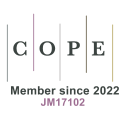REFERENCES
1. Yin J, Ye M, Yin Z, Xu S. A review of advances in urban flood risk analysis over China. Stoch Environ Res Risk Assess 2015;29:1063-70.
2. Zhang J, Wang Y, He R, Hu Q. Discussion on the urban flood and waterlogging and causes analysis in China. Adv Water Sci 2016;27:485-91 (In Chinese).
3. Lin T, Liu X, Song J, et al. Urban waterlogging risk assessment based on internet open data: A case study in China. Habitat Int 2018;71:88-96.
4. Yin J, Yu D, Yin Z, Liu M, He Q. Evaluating the impact and risk of pluvial flash flood on intra-urban road network: a case study in the city center of Shanghai, China. J Hydrol 2016;537:138-45.
5. Lyu HM, Sun WJ, Shen SL, Arulrajah A. Flood risk assessment in metro systems of mega-cities using a GIS-based modeling approach. Sci Total Environ 2018;626:1012-25.
6. Hou J, Du Y. Spatial simulation of rainstorm waterlogging based on a water accumulation diffusion algorithm. Geomat Nat Haz Risk 2020;11:71-87.
7. Tran D, Xu D, Dang V, Alwah A. Predicting urban waterlogging risks by regression models and internet open-data sources. Water 2020;12:879.
8. Chen Z, Li K, Du J, Chen Y, Liu R, Wang Y. Three-dimensional simulation of regional urban waterlogging based on high-precision DEM model. Nat Hazards 2021;108:2653-77.
9. Zhou M, Feng X, Liu K, Zhang C, Xie L, Wu X. An alternative risk assessment model of urban waterlogging: a case study of Ningbo city. Sustainability 2021;13:826.
10. Leandro J, Schumann A, Pfister A. A step towards considering the spatial heterogeneity of urban key features in urban hydrology flood modelling. J Hydrol 2016;535:356-65.
11. Song LX, Xu ZX. Coupled hydrologic-hydrodynamic model for urban rainstorm water logging simulation: recent advances. Nat Sci 2019; 55:581-587 (In Chinese).
12. Pandey AC, Singh SK, Nathawat MS. Waterlogging and flood hazards vulnerability and risk assessment in Indo Gangetic plain. Nat Hazards 2010;55:273-89.
13. Dang ATN, Kumar L. Application of remote sensing and GIS-based hydrological modelling for flood risk analysis: a case study of District 8, Ho Chi Minh city, Vietnam. Geomat Nat Haz Risk 2017;8:1792-811.
14. Wu X, Wang Z, Guo S, Liao W, Zeng Z, Chen X. Scenario-based projections of future urban inundation within a coupled hydrodynamic model framework: a case study in Dongguan City, China. J Hydrol 2017;547:428-42.
15. Zhang S, Pan B. An urban storm-inundation simulation method based on GIS. J Hydrol 2014;517:260-8.
16. Zhou QQ, Wang HP, Xu MM, Chen CB. A simplified GIS-based hydrological modelling approach for rapid flood risk assessment. China Water Wastewate ;31:109-13 (In Chinese).
17. Huang M, Jin S. A methodology for simple 2-D inundation analysis in urban area using SWMM and GIS. Nat Hazards 2019;97:15-43.
18. Meng X, Zhang M, Wen J, et al. A simple GIS-based model for urban rainstorm inundation simulation. Sustainability 2019;11:2830.
19. Gironás J, Roesner LA, Rossman LA, Davis J. A new applications manual for the Storm Water Management Model (SWMM). Environ Model Softw 2010;25:813-4.
20. Chang T, Wang C, Chen AS. A novel approach to model dynamic flow interactions between storm sewer system and overland surface for different land covers in urban areas. J Hydrol 2015;524:662-79.
21. Teng J, Jakeman A, Vaze J, Croke B, Dutta D, Kim S. Flood inundation modelling: a review of methods, recent advances and uncertainty analysis. Environ Model Softw 2017;90:201-16.
22. Fewtrell TJ, Bates PD, Horritt M, Hunter NM. Evaluating the effect of scale in flood inundation modelling in urban environments. Hydrol Process 2008;22:5107-18.
23. Bisht DS, Chatterjee C, Kalakoti S, Upadhyay P, Sahoo M, Panda A. Modeling urban floods and drainage using SWMM and MIKE URBAN: a case study. Nat Hazards 2016;84:749-76.
24. Bruni G, Reinoso R, van de Giesen NC, Clemens FHLR, Ten Veldhuis JAE. On the sensitivity of urban hydrodynamic modelling to rainfall spatial and temporal resolution. Hydrol Earth Syst Sci 2015;19:691-709.
25. Chen W, Huang G, Zhang H. Urban stormwater inundation simulation based on SWMM and diffusive overland-flow model. Water Sci Technol 2017;76:3392-403.
26. Abdelrahman YT, Moustafa AME, Elfawy M. Simulating flood urban drainage networks through 1D/2D model analysis. J Water Manag Model 2018;26:C454.
27. Salvadore E, Bronders J, Batelaan O. Hydrological modelling of urbanized catchments: a review and future directions. J Hydrol 2015;529:62-81.
28. Leandro J, Martins R. A methodology for linking 2D overland flow models with the sewer network model SWMM 5.1 based on dynamic link libraries. Water Sci Technol 2016;73:3017-26.
29. Paz AR, Serra LS, Silva MRDF, Meller A. Reducing computational runtime of two-dimensional urban inundation model by dynamic domain reshaping. J Hydrol Eng 2016;21:04016013.
30. Bates PD, Horritt MS, Fewtrell TJ. A simple inertial formulation of the shallow water equations for efficient two-dimensional flood inundation modelling. J Hydrol 2010;387:33-45.
31. Seyoum SD, Vojinovic Z, Price RK, Weesakul S. Coupled 1D and noninertia 2D flood inundation model for simulation of urban flooding. J Hydraul Eng 2012;138:23-34.
32. Bates P, De Roo A. A simple raster-based model for flood inundation simulation. J Hydrol 2000;236:54-77.
33. Biancamaria S, Bates PD, Boone A, Mognard NM. Large-scale coupled hydrologic and hydraulic modelling of the Ob river in Siberia. J Hydrol 2009;379:136-50.
34. Der Knijff JM, Younis J, De Roo APJ. LISFLOOD: a GIS-based distributed model for river basin scale water balance and flood simulation. Int J Geograp Inf Sci 2010;24:189-212.
35. Rajib A, Liu Z, Merwade V, Tavakoly AA, Follum ML. Towards a large-scale locally relevant flood inundation modeling framework using SWAT and LISFLOOD-FP. J Hydrol 2020;581:124406.
36. Fewtrell TJ, Duncan A, Sampson CC, Neal JC, Bates PD. Benchmarking urban flood models of varying complexity and scale using high resolution terrestrial LiDAR data. Phys Chem Earth 2011;36:281-91.
37. Neal J, Schumann G, Fewtrell T, Budimir M, Bates P, Mason D. Evaluating a new LISFLOOD-FP formulation with data from the summer 2007 floods in Tewkesbury, UK. J Flood Risk Manag 2011;4:88-95.
38. Sampson CC, Bates PD, Neal JC, Horritt MS. An automated routing methodology to enable direct rainfall in high resolution shallow water models. Hydrol Process 2013;27:467-76.
39. Mcdonnell B, Ratliff K, Tryby M, Wu J, Mullapudi A. PySWMM: the python interface to stormwater management model (SWMM). J Open Source Softw 2020;5:2292.
40. Shi Y, Shi C, Xu S, Sun A, Wang J. Exposure assessment of rainstorm waterlogging on old-style residences in Shanghai based on scenario simulation. Nat Hazards 2010;53:259-72.
41. BIGEMAP. Available from: http://www.bigemap.com/ [Last accessed on 8 Nov 2022].
42. Rossman LA, Simon MA. Storm water management model user’s manual version 5.2. Washington, DC: United States Environmental Protection Agency; 2022. pp. 206-21.






